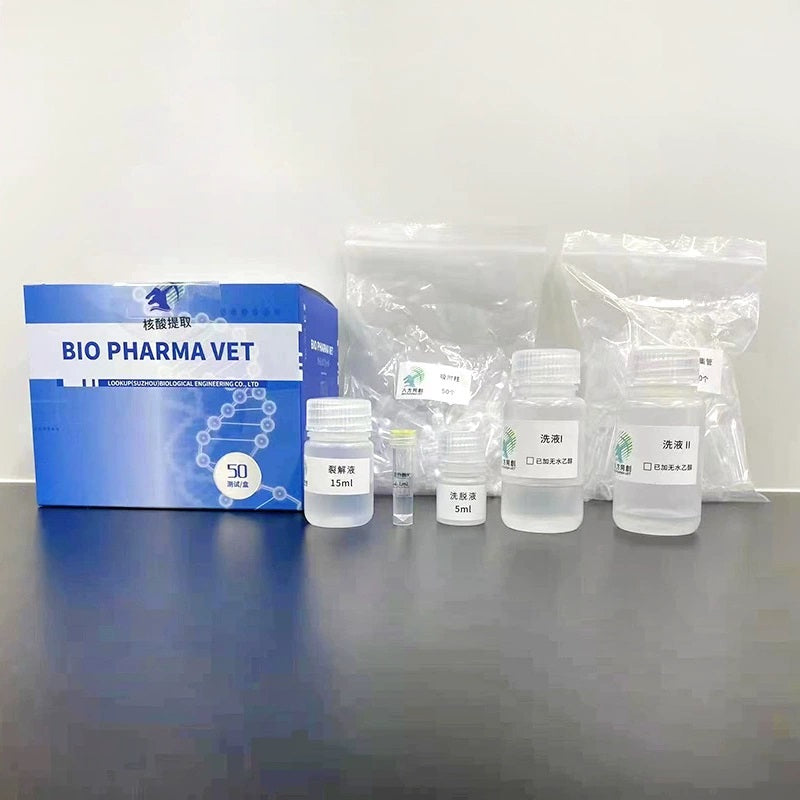1
/
of
3
Virus DNA/RNA Extraction Kit
Virus DNA/RNA Extraction Kit
Virus DNA/RNA Extraction Kit is mainly used for the extraction of anticoagulant, viral DNA / RNA in blood, serum, swab, tissue, feed and environment. The purified nucleic acid can be used for various routine operations and PCR tests.
Specification
Specification
The virus RNA and DNA column kit can extract 50 samples.
Precautions
Precautions
- Before the experiment, please read the kit instructions carefully, and strictly follow the operation steps. During the operation process, the accurate control of the time and reagent volume can obtain the best results.
- Samples should be collected and used freshly, or be transported and stored at low temperature.
- The sample has a potential risk of infection, and the nucleic acid extraction should be carried out in the biosafety cabinet of the nucleic acid extraction laboratory.
- Nucleic acid extraction Related consumables ensure high temperature sterilization. After extraction, nucleic acid should enter the next test as soon as possible or be cryopreserved.
- Reagents should be mixed evenly before use. Please wear protective gloves and masks because the reagents may be somewhat corrosive.
- The Lysate Solution crystallizes at low temperature is normal, which can be used after dissolving crystallization at 60℃ water bath.
- The waste generated by the experiment should be collected in time and kept away from the PCR laboratory for harmless treatment.
Storage
Storage
Put all unused reagents back into the kit and keep them properly.
Validity Period
Validity Period
The shelf life is 12 months when the kit is properly stored.



Product Information(Virus DNA/RNA Extraction Kit)
| Kit composition | Cat # HT-ZF | Storage |
| 1. Adsorption column | 50 | 2-30℃ |
| 2. Collect tubes | 50 | 2-30℃ |
| 3. The proteinase K | 1.1mL | 2-8℃ |
| 4. Lysate Solution | 15 mL | 2-30℃ |
| 5. Wash Solution 1 | 21 mL | 2-30℃ |
| 6. Wash Solution 2 | 7mL | 2-30℃ |
| 7. Eluent | 5mL | 2-30℃ |
Note: Before you use, make sure Wash Solution 1 has been added 14mL absolute ethanol, and Wash Solution 2 has been added 28mL absolute ethanol.
Required Materials Not Provided With the Kit
- Anhydrous ethanol, 1.5 mL sterile EP tube, normal saline or PBS (pH 7.4) buffer, etc.
- Vortex mixer.
- 20, 100, 200 and 1000 mL finnpipettes.
Operation Procedure
Sample Preparation
- Blood samples: Samples are centrifuged at 8000 rpm. for 2 minutes to take the upper serum which was placed in the sterilized centrifuge tube for reserve.
- Tissue samples: Collect 0.1 g of diseased tissue samples from spleen, liver, lymph nodes and tonsils, fully homogenate or grind in tissue homogenizer, add 1 mL PBS (PH 7.4) buffer, centrifuged at 8000 rpm for 2 min, take supernatant in the sterilized centrifuge tube for reserve.
- Oropharyngeal / nasal fluid samples: Samples are centrifuged at 8000 rpm. for 2 minutes, take supernatant in the sterilized centrifuge tube for reserve.
- Feed: Put the appropriate amount of ground feed (about 10g) into 50 mL EP tubes containing 10 mL PBS (PH 7.4) buffer, shake and mix, centrifuge at 8000 rpm. for 2 minutes, take the supernatant in the sterilized centrifuge tube for reserve.
- Environmental samples: Shake and mix, centrifuge at 8000 rpm. for 2 minutes, take the supernatant in the sterilized centrifuge tube for reserve.
Nucleic acid extraction
Amount of reagent required for one reaction is shown in the table below.
|
Volume per well |
|
| Sample |
200mL |
| Proteinase K |
20 mL |
| Lysate Solution |
250 mL |
| Anhydrous ethanol |
250 mL |
| Wash Solution1 |
600 mL |
| Wash Solution 2 |
600 mL |
| Eluent |
50mL |
Note: To ensure the elution efficiency, the eluate should be added to the central position of the centrifugal column.
- Add 250 mL lysate and 20 mL protease K into a new 1. 5 mL centrifuge tube.
- Add 200 mL samples to the centrifuge tube, reverse mix for 10 times, and place lysis samples at room temperature for 5 mins. (if the room temperature is low, lysis should be replied to 25℃)
- Add 250 mL anhydrous ethanol and mix in reverse for 10 seconds; if the sample is cloudy, centrifuge at 12000 rpm for 1 minute and remove the supernatant to avoid blocking the column;
- Transfer the supernatant into an adsorption column with a collection tube and be centrifuged at 12000 rpm for 1 minute.
- Discard the collection tube liquid, add 600 mL of Wash Solution1 to the adsorption column (please check whether 14 mL of absolute ethanol has been added), and centrifuge at 12,000 rpm for 1 minute;
- Discard the collection tube liquid, add 600 mL of Wash Solution 2 to the adsorption column (please check whether 28 mL of absolute ethanol has been added), and centrifuge at 12,000 rpm for 1 minute;
- Collection tube liquid was discarded and centrifuged at 12,000 rpm for 2 min to remove residual Wash Solution thoroughly.
- The adsorption column was transferred into a new nuclease-free 1.5 mL EP tube, dropped 50 mL eluate to the center of the column, let for 1 minute, centrifuged at 12000 rpm for 1 minute. The liquid in the EP tube is nucleic acid. The nucleic acid is used immediately or stored -20℃.



